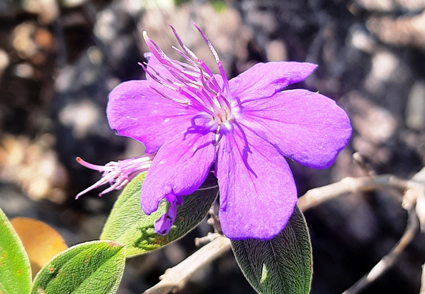Abstract
We describe here the new species Pleroma goyazense, including illustrations, geographic distribution, habitat data, and preliminary conservation status according to the International Union for Conservation of Nature (IUCN) Red list criteria. We also propose to synonymize Pleroma nodosum under Pleroma robustum, a decision corroborated by the study of Pleroma species with similarities to P. goyazense. Pleroma goyazense is endemic to the state of Goiás, Brazil, occurring in cerrado rupestre (rupestrine savanna) on rocky outcrops or crevices, environments that are also shared by similar species P. crassirame and P. robustum. Pleroma goyazense differs from P. crassirame in having sparsely leaves arranged on the upper branches and pedoconnective stamens with a dorsal appendage. It also differs from P. robustum in having lanceolate, non-involucral bracteoles, and sepals acuminate at the apex.
References
- Aublet, J.B.C.F. (1775) Histoire des Plantes de la Guiane Françoise Tome I. Pierre François Didot, London, 621 pp.
- Bachman, S., J. Moat, A.W. Hill, J. de la Torre & Scott, B. (2011) Supporting Red List threat assessments with GeoCAT: Geospatial conservation assessment tool. ZooKeys 150: 117–126. https://doi.org/10.3897/zookeys.150.2109
- Chapman, A.D. & Wieczorek, J.R. (2020) Georeferencing Best Practices. Copenhagen: GBIF Secretariat. https://doi.org/10.15468/doc-gg7h-s853
- Cogniaux, A.C. (1885) Tibouchinieae. In: Martius, C.F.P., Eichler, A.W. & Urban, I. (Eds.) Flora Brasiliensis, vol. 14 (3). Fleischer, Leipzig, pp. 6–510.
- De Candolle, A.P. (1828) Melastomataceae. In: De Candolle, A.L.P.P. (Ed.) Prodromus Systematis Naturalis Regni Vegetabilis 3. Treuttel et Würtz, Paris, pp. 99–202.
- Don, D. (1823) An Illustration of the Natural Family of Plants called Melastomaceae. Memoirs of the Wernerian Natural History Society 4: 276–329.
- Guimarães, P.J.F. (2022) Pleroma in Flora do Brasil 2020. Jardim Botânico do Rio de Janeiro. Available from: https://floradobrasil2020.jbrj.gov.br/FB134028 (accessed 27 Oct. 2023).
- Guimarães, PJ.F. & Martins, A.B. (1997) Tibouchina sect. Pleroma (D. Don) Cogn. (Melastomataceae) no estado de São Paulo. Revista Brasileira de Botânica 20 (1): 11–33. https://doi.org/10.1590/S0100-84041997000100002
- Guimarães, P.J.F., Michelangeli, F.A., Sosa, K. & Gomez, J.R.S. (2019) Systematics of Tibouchina and allies (Melastomataceae: Melastomateae): a new taxonomic classification. Taxon 68: 937–1002. https://doi.org/10.1002/tax.12151
- Guimarães, P.J.F., Ranga, N.T. & Martins, A.B. (1999) Morfologia dos tricomas em Tibouchina sect. Pleroma (D. Don) Cogn. (Melastomataceae). Brazilian Archives of Biology and Technology 42 (4): 485–493.
- IBGE [Instituto Brasileiro de Geografia e Estatística] (2022) Available from: https://cidades.ibge.gov.br/brasil/go/historico (accessed 4 September 2023).
- IUCN [International Union for Conservation of Nature] (2012) IUCN red list categories and criteria. Version 3.1. Ed. 2. Gland, Switzerland and Cambridge, UK: IUCN.
- IUCN [International Union for Conservation of Nature] (2022) Guidelines for using the IUCN Red List Categories and Criteria. Version 15. Prepared by the Standards and Petitions Committee. Available from: https://www.iucnredlist.org/documents/RedListGuidelines.pdf (accessed 12 September 2023).
- Machado, A.I.M.R. & Romero, R. (2020) Melastomataceae in the Parque Estadual da Serra Dourada, Goiás State, Brazil. Phytotaxa 450 (1): 17–54. https://doi.org/10.11646/phytotaxa.450.1.3
- Magdalena, U.R., Silva, L.A.E., Lima, R.O., Bellon, E., Ribeiro, R., Oliveira, F.A., Siqueira, M.F. & Forzza, R.C. (2018) A new methodology for the retrieval and evaluation of geographic coordinates within databases of scientific plant collections. Applied Geography 96: 11–15. https://doi.org/10.1016/j.apgeog.2018.05.002
- Oliveira, A.L.F., Romero, R. & Guimarães, P.J.F. (2016) A tribo Melastomeae (Melastomataceae) no estado de Goiás. Heringeriana 10: 78–131. https://doi.org/10.17648/heringeriana.v10i2.222
- Quintela, A.C. (2003) O Topônimo “Goyaz”. Signótica 15 (2): 153–172. https://doi.org/10.5216/sig.v15i2.16216
- Radford, A.E., Dickison, W.C., Massey, J.R. & Bell, C.R. (1986) Vascular Plants Systematics. New York: Harper and Row Publishers.
- Thiers, B. (2023) Index Herbariorum: A global directory of public herbaria and associated staff. New York Botanical Garden’s Virtual Herbarium. Available from: http://sweetgum.nybg.org/science/ih/ (accessed 3 February 2023).
- Taubert, P. (1896) Beiträge zur Kenntnis der Flora der centralbrasilianischen Staates Goyaz. Botanisches Jahrbüchen für Systematik, Pflanzengeschichte und Pflanzengeographie 21: 402–457.
- Triana, J. (1872) Les Melastomataceìes. The Transactions of the Linnean Society of London 28: 44. https://doi.org/10.1111/j.1096-3642.1871.tb00222.x
- Versiane, A.F.A. & Romero, R. (2016) Melastomataceae da Serra dos Pirineus, Goiás, Brasil. Rodriguésia (Impresso) 67: 721–759. https://doi.org/10.1590/2175-7860201667314
- Wurdack, J.J. (1959) The Machris Brazilian Expedition Botany: Phanerogamiae, Melastomataceae and Polygalaceae. Los Angeles County Museum Contributions in Science 28: 3–11. https://doi.org/10.5962/p.241074
- Wurdack, J.J. (1986) Atlas of hairs for neotropical Melastomataceae. Smithsonian Contributions to Botany 63: 1–80. https://doi.org/10.5479/si.0081024X.63


